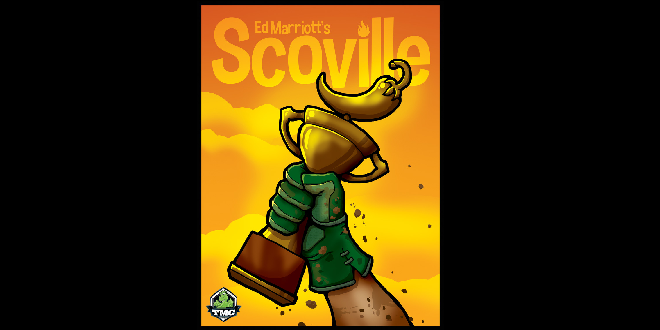One of my absolute favorite board games growing up was The Farming Game. It uses outdated roll-to-move mechanics similar to Monopoly and sees players moving around the board, planting various crops, and raising livestock on their farms while hoping to land in the right areas on the board to harvest those same crops and livestock. The Farming Game isn't very good, but I love the theme, and it still holds a special place in my heart—I would still play it from time to time even though the mechanics are clunky and archaic. Now, after having played Scoville by designer Ed Marriott and publisher Tasty Minstrel Games, The Farming Game is officially retired from my collection. Scoville hits all of the high notes of The Farming Game, but does it so much better, replacing all of the dice-fest luck elements with player agency and strategic options, and tops it off using a family friendly, light-hearted theme about growing the hottest chili peppers possible.
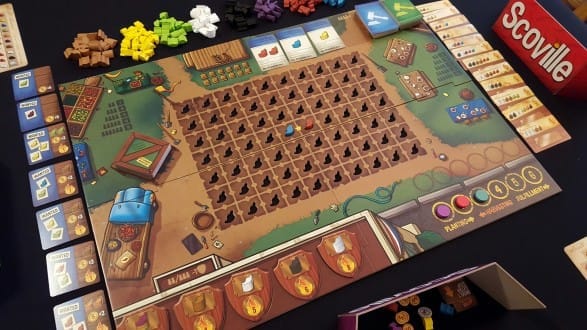
There are four main phases in Scoville that, while completely different, work in concert to allow players to really form both short and long term strategies. Scoville neatly ties together auction mechanics, points rush, worker placement/movement and resource management in a way that feels equally thematic, strategic, and fun.
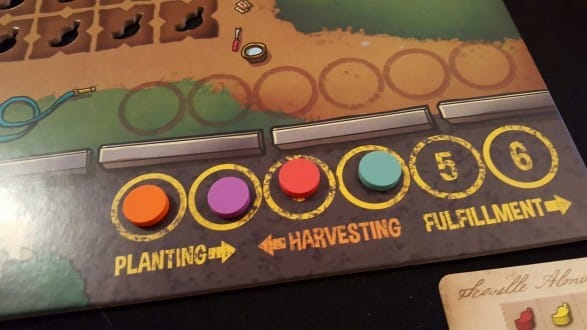
The Auction phase leads off each round and has players bid against one another in order to choose turn order. Success in Scoville isn't simply a matter of going first each round though. While the first player each round does get the first choice of peppers that are up for Auction in a round, and also has them plant a pepper first each round, the turn order is reversed for the vital Harvesting phase. It is often likely that multiple players will want to Harvest first, and often those players will bid specifically in an effort to choose to be last in turn order.
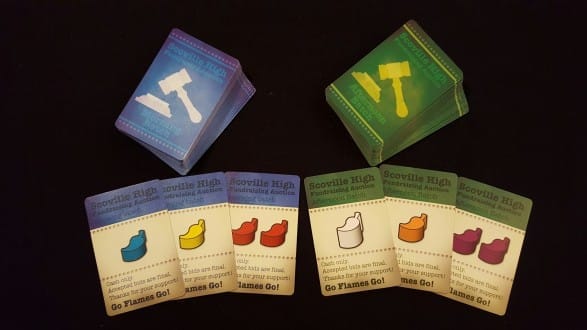
Immediately after turn order has been determined, and players have received their Auction peppers, each player is required to plant one pepper. The peppers players will get during the Harvesting round are determined by which peppers have been planted, so players will often try to set themselves up to Harvest the types of peppers that they need to fulfill their plans. Planting first gives the player the first chance to claim Plaques, which are worth points to players for planting certain types of peppers, but, since the first player to plant will Harvest last, they can be left at the mercy of their opponents, and can see their planned path blocked by savvy players.
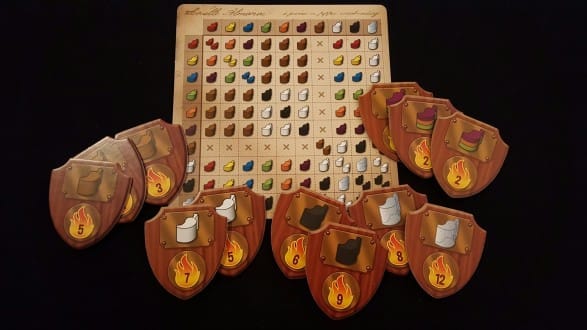
The Harvest phase is interesting because it allows players to harvest new peppers based on what has been planted. The peppers gained are determined by which two peppers their farmer is standing between after they take each of their three allowed steps each round. The higher point Plaques and Recipes require peppers that are more difficult to Breed, and players aren't generally allowed to backtrack while Harvesting, so taking an efficient route between the various planted peppers is a must.
Additionally, players can block one another with their farmers if they stop in the right spot. Smart players can gather peppers to further their goals while blocking off valuable routes or stopping in between two peppers that produce a valuable hybrid. This is why players will often vie for the last position in turn order. The last player in turn order is the last to plant, and the first to move, so they can take advantage of the new possible combinations while moving to block valuable peppers from the other players.
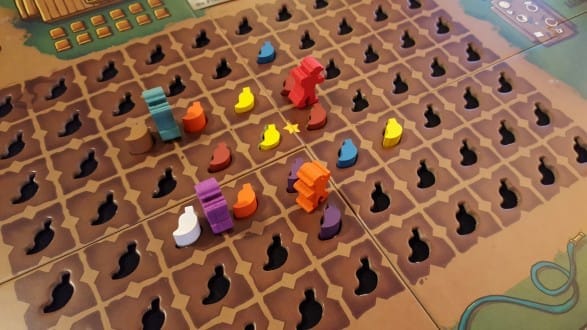
After each player has had a chance to Harvest, players take turns, in regular turn order, during the Fulfillment phase. In this phase the players can sell their peppers for coins, turn them in at the Market, or claim Recipe cards by turning in all of the required peppers. The Recipes offer players the chance at the biggest point rewards and simultaneously act as the game's timer, so it pays for players to be as efficient as possible. Turn order reverts to normal for the Fulfillment phase, so even though it can be tempting to always be the first to Harvest, it can also bite players when a valuable Recipe that they have been gunning for gets claimed just before they get the chance to claim it themselves. Those high point value Recipes require quite a bit of planning and effort, so it really pays to be able to think and plan ahead, often multiple rounds in advance, in Scoville.
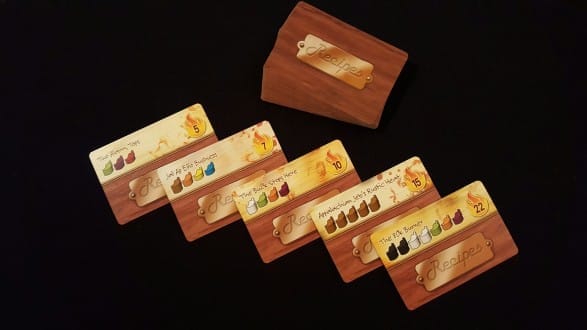
Scoville is still a great game for players who can't, or don't want to, plan multiple rounds ahead though. It can be just as important to react smartly to what the other players are doing than to try to create one set plan and stick to it unwaveringly. The depth and strategy are there for players who really want to dig in to it, but the theme and mechanics are straightforward and light-hearted enough that players who just want to play and have a good time can do so. Regardless of your approach, Scoville is great fun.
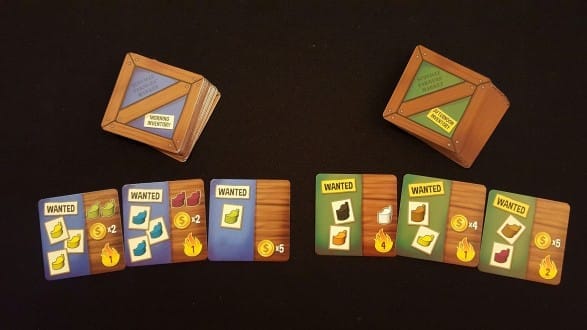
A note on “chrome”: Scoville has high quality components and a great rulebook. The board is four sections that slot together nicely, with cutouts to slot each pepper into as they are planted. The art is almost uniformly excellent with a few small exceptions. The red peppers are more maroon in color, as opposed to the vibrant red on the cards and on the red player tokens. This can cause some confusion when looking across the table at the Market and Recipe cards. This confusion can be exacerbated because the cards, especially the Recipe cards, are small and the Recipes are so vital to success. It can be very difficult, especially with a full compliment of Recipe cards on the table, to see exactly what is required for each, and play can slow down considerably as players across the table have to constantly ask to see, or be told, what peppers each Recipe needs.
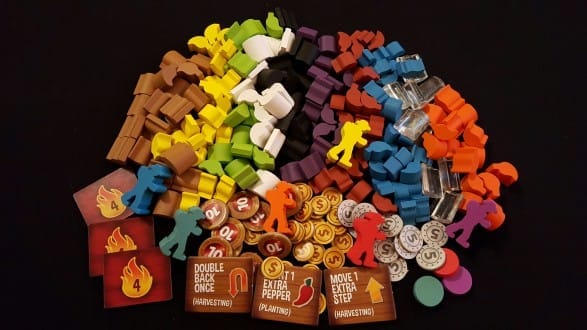
The bottom line:
Scoville is a great game with a fun theme that evokes happy memories and good vibes. The mechanics are straightforward, but the need to plan a head to be successful can lead to some serious brain burning analysis paralysis. The turn order flip-flopping between phases means that one position in the order isn't always going to be the best choice, adding depth and strategy to what is often a black and white choice in most other games. Even though the game can slow down as people plan ahead, the game length is dependent upon how quickly Market cards and Recipes are claimed, so experienced players tend to finish the game in fewer rounds, keeping the play time fairly consistent even as longer term strategies are formulated. The light-hearted, pepper planting theme is perfect for groups who like to get competitive but prefer to do so in a family friendly way. The only real downside is the size of the Recipe cards. Up to 24 Recipe cards will be on the table at any one time, and the points they offer are vital, so it's unfortunate that they can be so hard to see.
Get this game if:
You like strategic games that allow you to plan ahead.
You like games where each disparate phase matters to your overall strategy.
You like nonviolent themes.
You like Euro games that let you interfere with, and play off of your opponents.
Avoid this game if:
You prefer multiplayer-solitaire Euro games where player interaction and interference are kept to a minimum.
You prefer games that are strictly, directly, confrontational.
The copy of Scoville used for this review was provided by Tasty Minstrel Games.
Review Summary
Tasty Minstrel Games has another great game on their hands with Scoville. The theme and mechanics are easy to grasp and light enough for a family game night while allowing enough depth for the strategically minded.
(Review Policy)Have a tip, or want to point out something we missed? Leave a Comment or e-mail us at tips@techraptor.net
